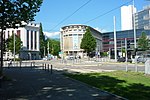Natural History Museum, Grenoble
French museum stubsMonuments historiques of IsèreMuseums established in 1773Museums in GrenobleNatural history museums in France

The Natural History Museum of Grenoble (French: Muséum d'histoire naturelle de Grenoble) is a municipal museum founded in 1851, in Grenoble, France. Since the opening of the building in 1855, it presents to the public a rich natural heritage, in particular alpine heritage. The museum houses a collection of one and a half million objects and specimens in the disciplines of botany, zoology, geology and even ethnology. Facades and roofs on the edge of the Jardin des Plantes (Plants Garden) have been listed as historical monuments since January 24, 1944.
Excerpt from the Wikipedia article Natural History Museum, Grenoble (License: CC BY-SA 3.0, Authors, Images).Natural History Museum, Grenoble
Rue Dolomieu, Grenoble Secteur 2
Geographical coordinates (GPS) Address Phone number Website Nearby Places Show on map
Geographical coordinates (GPS)
| Latitude | Longitude |
|---|---|
| N 45.188 ° | E 5.7352 ° |
Address
Muséum d'histoire naturelle
Rue Dolomieu 1
38000 Grenoble, Secteur 2
Auvergne-Rhône-Alpes, France
Open on Google Maps










